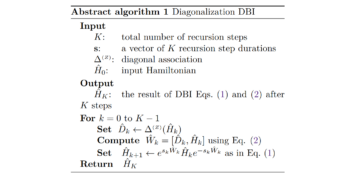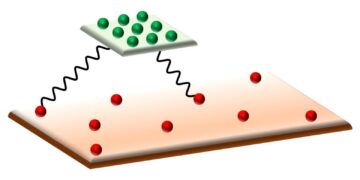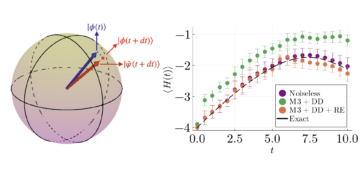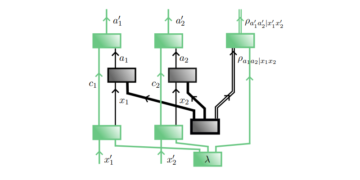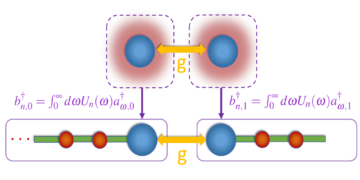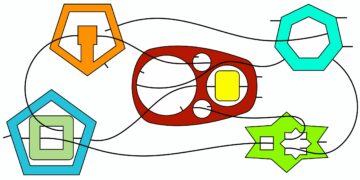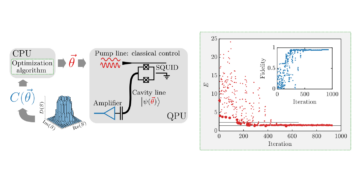
理论物理研究所,UIBK,6020 因斯布鲁克,奥地利
觉得本文有趣或想讨论? 在SciRate上发表评论或发表评论.
抽象
学习量子系统的隐藏属性通常需要一系列的相互作用。在这项工作中,我们使用经典量子态的概括(称为经典量子梳)来形式化这种多轮学习过程。这里,“经典”是指编码要学习的隐藏属性的随机变量,“量子”是指描述系统行为的量子梳。学习隐藏属性的最佳策略可以通过将梳最小熵(Chiribella 和 Ebler,NJP,2016)应用于经典量子梳来量化。为了展示这种方法的强大功能,我们将注意力集中在基于测量的量子计算 (MBQC) 和相关应用产生的一系列问题上。具体来说,我们使用梳形式描述了一种已知的盲量子计算(BQC)协议,从而利用最小熵为协议的多轮提供单次安全性证明,扩展了文献中的现有结果。此外,我们考虑了一系列与验证部分未知的 MBQC 设备相关的操作动机示例。这些示例涉及学习正确使用设备所需的功能,包括学习其用于测量校准的内部参考系。我们还介绍了在这种背景下出现的 MBQC 和量子因果模型之间的新颖联系。
热门摘要
►BibTeX数据
►参考
[1] John Preskill “NISQ 时代及以后的量子计算” Quantum 2, 79 (2018)。
https://doi.org/10.22331/q-2018-08-06-79
[2] H.-J。 Briegel、W. Dür、J. I. Cirac 和 P. Zoller,“量子中继器:不完美局域操作在量子通信中的作用”。莱特牧师。 81、5932-5935(1998)。
https:/ / doi.org/ 10.1103 / PhysRevLett.81.5932
[3] Rodney Van Meter“量子网络”ISTE Ltd/John Wiley Sons Inc,新泽西州霍博肯 (2014)。
https:/ / doi.org/10.1002/ 9781118648919
[4] Davide Castelvecchi “量子互联网已经到来(但它还没有到来)。”自然 554, 289–293 (2018)。
https://doi.org/10.1038/d41586-018-01835-3
[5] 廖胜凯、蔡文琪、约翰内斯·汉斯坦纳、刘博、尹娟、张亮、多米尼克·劳赫、马蒂亚斯·芬克、任吉刚和刘伟跃,“卫星中继洲际量子网络”物理评论信120, 030501 (2018)。
https:/ / doi.org/ 10.1103 / PhysRevLett.120.030501
[6] CT Nguyen、DD Sukachev、MK Bhaskar、Bartholomeus Machielse、DS Levonian、EN Knall、Pavel Stroganov、Ralf Riedinger、Hongkun Park 和 M Lončar,“基于具有高效纳米光子接口的金刚石量子位的量子网络节点”物理评论信件 123, 183602(2019)。
https:/ / doi.org/ 10.1103 / PhysRevLett.123.183602
[7] Peter C Humphreys、Norbert Kalb、Jaco PJ Morits、Raymond N Schouten、Raymond FL Vermeulen、Daniel J Twitchen、Matthew Markham 和 Ronald Hanson,“量子网络上远程纠缠的确定性传递” Nature 558, 268–273 (2018) 。
https://doi.org/10.1038/s41586-018-0200-5
[8] Boris Korzh、Charles Ci Wen Lim、Raphael Houlmann、Nicolas Gisin、Ming Jun Li、Daniel Nolan、Bruno Sanguinetti、Rob Thew 和 Hugo Zbinden,“在 307 公里光纤上实现安全实用的量子密钥分发”Nature Photonics 9, 163–168(2015)。
https:///doi.org/10.1038/nphoton.2014.327
[9] Rachel Courtland“中国 2,000 公里量子链路即将完成”IEEE Spectrum 53, 11-12 (2016)。
https:// / doi.org/ 10.1109/ MSPEC.2016.7607012
[10] Mohamed Elboukhari、Mostafa Azizi 和 Abdelmalek Azizi,“量子密钥分发协议:一项调查”。国际通用计算机科学杂志 1 (2010)。
https:// / doi.org/ 10.1109/ ICWT.2018.8527822
[11] Angela Sara Cacciapuoti、Marcello Caleffi、Francesco Tafuri、Francesco Saverio Cataliotti、Stefano Gherardini 和 Giuseppe Bianchi,“量子互联网:分布式量子计算中的网络挑战”IEEE Network 34, 137–143 (2019)。
https://doi.org/10.1109/MNET.001.1900092
[12] 量子互联网联盟 https://quantum-internet.team (2022)。
https:/ / doi.org/10.3030/ 101102140
https://quantum-internet.team
[13] 安东尼奥·阿辛、伊曼纽尔·布洛赫、哈里·布尔曼、托马索·卡拉科、克里斯托弗·艾希勒、延斯·艾塞特、丹尼尔·埃斯特夫、尼古拉斯·吉辛、斯蒂芬·J·格拉泽、费多尔·耶莱兹科、斯特凡·库尔、马切伊·莱文斯坦、马克斯·弗里德尔、皮特·奥·施密特、罗伯·修、安德烈亚斯·沃拉夫, Ian Walmsley 和 Frank K Wilhelm,“量子技术路线图:欧洲共同体观点”,New Journal of Physics 20, 080201 (2018)。
https:/ / doi.org/ 10.1088 / 1367-2630 / aad1ea
[14] Robert Beals、Stephen Brierley、Oliver Gray、Aram W Harrow、Samuel Kutin、Noah Linden、Dan Shepherd 和 Mark Stather,“高效分布式量子计算”英国皇家学会论文集 A:数学、物理和工程科学 469,20120686(2013 年) )。
https:/ / doi.org/ 10.1098 / rspa.2012.0686
[15] Vasil S Denchevand Gopal Pandurangan “分布式量子计算:分布式系统的新前沿还是科幻小说?” ACM SIGACT 新闻 39, 77–95 (2008)。
https:/ / doi.org/10.1145/ 1412700.1412718
[16] Rene Allerstorfer、Harry Buhrman、Florian Speelman 和 Philip Verduyn Lunel,“论量子通信的作用和量子位置验证攻击中的丢失”arXiv:2208.04341 (2022)。
https:///doi.org/10.48550/ARXIV.2208.04341
https:///arxiv.org/abs/2208.04341
[17] Joseph F Fitzsimons “私有量子计算:盲量子计算和相关协议简介”npj Quantum Information 3, 1–11 (2017)。
https://doi.org/10.1038/s41534-017-0025-3
[18] Giulio Chiribella、Giacomo Mauro D'Ariano 和 Paolo Perinotti,“量子网络的理论框架”物理评论 A 80,022339(2009 年)。
https:/ / doi.org/ 10.1103 / PhysRevA.80.022339
[19] Giulio Chiribella、G Mauro D’Ariano 和 Paolo Perinotti,“量子电路架构”物理评论信件 101, 060401 (2008)。
https:/ / doi.org/ 10.1103 / PhysRevLett.101.060401
[20] Michael A. Nielsenand Isaac L. Chuang,“量子计算和量子信息:十周年版”,剑桥大学出版社,10年。
https:/ / doi.org/ 10.1017 / CBO9780511976667
[21] Felix A Pollock、César Rodríguez-Rosario、Thomas Frauenheim、Mauro Paternostro 和 Kavan Modi,“非马尔可夫量子过程:完整的框架和有效的表征”物理评论 A 97, 012127 (2018)。
https:/ / doi.org/ 10.1103 / PhysRevA.97.012127
[22] Giulio Chiribella 和 Daniel Ebler“最优量子网络和一次性熵”《新物理学杂志》18, 093053 (2016)。
https://doi.org/10.1088/1367-2630/18/9/093053
[23] Robert Konig、Renato Renner 和 Christian Schaffner,“最小和最大熵的操作意义”IEEE Transactions on Information Theory 55, 4337–4347 (2009)。
https:///doi.org/10.1109/TIT.2009.2025545
[24] Renato Renner“量子密钥分发的安全性”国际量子信息杂志 6, 1–127 (2008)。
https:/ / doi.org/ 10.1142 / S0219749908003256
[25] 马克·M·王尔德《量子信息论》剑桥大学出版社(2017 年)。
https:/ / doi.org/10.1017/ 9781316809976
[26] Robert Raussendorfand Hans J Briegel“单向量子计算机”物理评论信件 86, 5188 (2001)。
https:/ / doi.org/ 10.1103 / PhysRevLett.86.5188
[27] Hans J Briegel、Daniel E Browne、Wolfgang Dür、Robert Raussendorf 和 Maarten Van den Nest,“基于测量的量子计算”《自然物理学》5, 19–26 (2009)。
https:/ / doi.org/ 10.1038 / nphys1157
[28] Robert Raussendorf、Daniel E Browne 和 Hans J Briegel,“基于测量的簇态量子计算”物理评论 A 68, 022312 (2003)。
https:/ / doi.org/ 10.1103 / PhysRevA.68.022312
[29] Robert Raussendorfand Hans Briegel“单向量子计算机的计算模型”arXiv 预印本 quant-ph/0108067 (2001)。
https://doi.org/10.48550/arXiv.quant-ph/0108067
[30] Richard Jozsa“基于测量的量子计算简介”北约科学系列,III:计算机和系统科学。量子信息处理——从理论到实验 199, 137–158 (2006)。
https://doi.org/10.48550/arXiv.quant-ph/0508124
[31] D Grossand J Eisert“基于测量的量子计算的新颖方案”物理评论快报 98, 220503 (2007)。
https:/ / doi.org/ 10.1103 / PhysRevLett.98.220503
[32] Hans J Briegeland Robert Raussendorf “相互作用粒子阵列中的持久纠缠”物理评论快报 86, 910 (2001)。
https:/ / doi.org/ 10.1103 / PhysRevLett.86.910
[33] Marc Hein、Wolfgang Dür、Jens Eisert、Robert Raussendorf、M Van den Nest 和 H J Briegel,“图状态中的纠缠及其应用”arXiv 预印本 quant-ph/0602096 (2006)。
https://doi.org/10.48550/arXiv.quant-ph/0602096
[34] Marc Hein、Wolfgang Dür、Jens Eisert、Robert Raussendorf、M Van den Nest 和 H J Briegel,“图状态中的纠缠及其应用”第 162 卷:量子计算机、算法和混沌 115-218 (2006)。
https://doi.org/10.3254/978-1-61499-018-5-115
[35] Marc Hein、Jens Eisert 和 Hans J Briegel,“图状态中的多方纠缠”Physical Review A 69, 062311 (2004)。
https:/ / doi.org/ 10.1103 / PhysRevA.69.062311
[36] Mehdi Mhalla、Mio Murao、Simon Perdrix、Masato Someya 和 Peter S Turner,“哪些图状态对于量子信息处理有用?”量子计算、通信和密码学会议 174-187 (2011)。
https://doi.org/10.1007/978-3-642-54429-3_12
[37] Daniel E Browne、Elham Kashefi、Mehdi Mhalla 和 Simon Perdrix,“基于测量的量子计算中的广义流和决定论”《新物理学杂志》9, 250 (2007)。
https://doi.org/10.1088/1367-2630/9/8/250
[38] Vincent Danosand Elham Kashefi“单向模型中的决定论”物理评论 A 74, 052310 (2006)。
https:/ / doi.org/ 10.1103 / PhysRevA.74.052310
[39] Damian Markhamand Elham Kashefi “基于测量的量子计算中的纠缠、流动和经典可模拟性”Springer (2014)。
https://doi.org/10.1007/978-3-319-06880-0_22
[40] Vincent Danos、Elham Kashefi 和 Prakash Panangaden,“测量演算”ACM 杂志 (JACM) 54, 8–es (2007)。
https:/ / doi.org/10.1145/ 1219092.1219096
[41] Maarten Van den Nest、Jeroen Dehaene 和 Bart De Moor,“局部 Clifford 变换对图状态的作用的图形描述”Physical Review A 69, 022316 (2004)。
https:/ / doi.org/ 10.1103 / PhysRevA.69.022316
[42] Maarten Van den Nest、Jeroen Dehaene 和 Bart De Moor,“稳定器状态的局域酉与局域 Clifford 等价”物理评论 A 71, 062323 (2005)。
https:/ / doi.org/ 10.1103 / PhysRevA.75.032325
[43] Philip Walther、Kevin J Resch、Terry Rudolph、Emmanuel Schenck、Harald Weinfurter、Vlatko Vedral、Markus Aspelmeyer 和 Anton Zeilinger,“实验单向量子计算”Nature 434, 169–176 (2005)。
https:/ / doi.org/10.1038/nature03347
[44] Robert Raussendorf、Jim Harrington 和 Kovid Goyal,“簇态量子计算中的拓扑容错”《新物理学杂志》9, 199 (2007)。
https://doi.org/10.1088/1367-2630/9/6/199
[45] M. S. Tame、R. Prevedel、M. Paternostro、P. Böhi、M. S. Kim 和 A. Zeilinger,“单向量子计算机中 Deutsch 算法的实验实现”。莱特牧师。 98、140501(2007)。
https:/ / doi.org/ 10.1103 / PhysRevLett.98.140501
[46] Anne Broadbent、Joseph Fitzsimons 和 Elham Kashefi,“通用盲量子计算”2009 年第 50 届 IEEE 计算机科学基础研讨会 517-526 (2009)。
https:///doi.org/10.1109/FOCS.2009.36
[47] Atul Mantri、Tommaso F Demarie、Nicolas C Menicucci 和 Joseph F Fitzsimons,“流模糊性:通向经典驱动盲量子计算的道路”《物理评论 X 7》,031004 (2017)。
https:/ / doi.org/ 10.1103 / PhysRevX.7.031004
[48] Tomoyuki Morimae 和 Keisuke Fujii “Alice 仅进行测量的盲量子计算协议”Physical Review A 87, 050301 (2013)。
https:/ / doi.org/ 10.1103 / PhysRevA.87.050301
[49] Tomoyuki Morimae“仅测量盲量子计算的验证”物理评论 A 89, 060302 (2014)。
https:/ / doi.org/ 10.1103 / PhysRevA.89.060302
[50] Christopher Portmannand Renato Renner “量子密码学的安全性”现代物理学评论 94, 025008 (2022)。
https:/ / doi.org/ 10.1103 / RevModPhys.94.025008
[51] Jonathan Barrett、Robin Lorenz 和 Ognyan Oreshkov,“量子因果模型”arXiv 预印本 arXiv:1906.10726 (2019)。
https://doi.org/10.48550/arXiv.1906.10726
[52] Fabio Costa 和 Sally Shrapnel“量子因果模型”《新物理学杂志》18, 063032 (2016)。
https://doi.org/10.1088/1367-2630/18/6/063032
[53] John-Mark A Allen、Jonathan Barrett、Dominic C Horsman、Ciarán M Lee 和 Robert W Spekkens,“量子常见原因和量子因果模型”《物理评论 X》7,031021 (2017)。
https:/ / doi.org/ 10.1103 / PhysRevX.7.031021
[54] Katja Ried、Megan Agnew、Lydia Vermeyden、Dominik Janzing、Robert W Spekkens 和 Kevin J Resch,“推断因果结构的量子优势”,《自然物理学》11, 414–420 (2015)。
https:/ / doi.org/ 10.1038 / nphys3266
[55] Joseph F Fitzsimons、Jonathan A Jones 和 Vlatko Vedral,“暗示因果关系的量子相关性”科学报告 5, 1–7 (2015)。
https:/ / doi.org/ 10.1038 / srep18281
[56] Giulio Chiribella 和 Daniel Ebler “因果关系识别中的量子加速”自然通讯 10, 1-8 (2019)。
https://doi.org/10.1038/s41467-019-09383-8
[57] Jonas M Küblerand Daniel Braun“双量子位因果结构和正量子位图的几何”《新物理学杂志》20, 083015 (2018)。
https:///doi.org/10.1088/1367-2630/aad612
[58] Man-Duen Choi “复杂矩阵上的完全正线性映射”线性代数及其应用 10, 285–290 (1975)。
https://doi.org/10.1016/0024-3795(75)90075-0
[59] Andrzej Jamiołkowski “保留算子的迹和正半定性的线性变换”《数学物理报告》3,275-278 (1972)。
https://doi.org/10.1016/0034-4877(72)90011-0
[60] Heinz-Peter Breuerand Francesco Petruccione “开放量子系统理论”,牛津大学出版社,美国(2002 年)。
https:///doi.org/10.1093/acprof:oso / 9780199213900.001.0001
[61] 菲利普·佩丘卡斯(Philip Pechukas)“减少动力不一定是完全积极的”物理。莱特牧师。 73、1060-1062(1994)。
https:/ / doi.org/ 10.1103 / PhysRevLett.73.1060
[62] 罗伯特·阿里奇“对“降低动力学不一定是完全积极的”的评论”物理。莱特牧师。 75, 3020–3020 (1995)。
https:/ / doi.org/ 10.1103 / PhysRevLett.75.3020
[63] 菲利普·佩丘卡斯“佩丘卡斯回复:”物理。莱特牧师。 75, 3021–3021 (1995)。
https:/ / doi.org/ 10.1103 / PhysRevLett.75.3021
[64] 安托万·罗耶(Antoine Royer)“具有初始相关性的简化动力学、瞬态环境和哈密顿量”物理。莱特牧师。 77, 3272–3275 (1996)。
https:/ / doi.org/ 10.1103 / PhysRevLett.77.3272
[65] Simon Milz、Felix A Pollock 和 Kavan Modi,“操作量子动力学简介”开放系统与信息动力学 24, 1740016 (2017)。
https:/ / doi.org/ 10.1142 / S1230161217400169
[66] Gus Gutoski 和 John Watrous “迈向量子博弈的一般理论”第三十九届 ACM 计算理论年度研讨会论文集 565-574 (2007)。
https:/ / doi.org/10.1145/ 1250790.1250873
[67] Ognyan Oreshkov、Fabio Costa 和 Časlav Brukner,“无因果顺序的量子相关性”自然通讯 3, 1–8 (2012)。
https:///doi.org/10.1038/ncomms2076
[68] Jonathan Barrett、Robin Lorenz 和 Ognyan Oreshkov,“循环量子因果模型”,《自然通讯》12, 1–15 (2021)。
https:///doi.org/10.1038/s41467-020-20456-x
[69] Giacomo Mauro D’Ariano“因果关系重新建立”皇家学会哲学汇刊 A:数学、物理和工程科学 376, 20170313 (2018)。
https:/ / doi.org/ 10.1098 / rsta.2017.0313
[70] Alexander S Holevo“量子理论的概率和统计方面”Edizioni della Normale Pisa (2011)。
https://doi.org/10.1007/978-88-7642-378-9
[71] A. S. Holevo“量子物理学中的统计问题”第二届日本-苏联概率论研讨会论文集 104-119(1973)。
https:/ / doi.org/ 10.1007 / BFb0061483
[72] Carl W Helstrom“检测理论和量子力学”信息与控制 10, 254–291 (1967)。
https://doi.org/10.1016/S0019-9958(67)90302-6
[73] Alexander S Holevo“量子系统的统计决策理论”多元分析杂志 3, 337–394 (1973)。
https://doi.org/10.1016/0047-259X(73)90028-6
[74] Simon Milz、Dario Egloff、Philip Taranto、Thomas Theurer、Martin B. Plenio、Andrea Smirne 和 Susana F. Huelga,“非马尔可夫量子过程什么时候是经典的?”物理。修订版 X 10, 041049 (2020)。
https:/ / doi.org/ 10.1103 / PhysRevX.10.041049
[75] Marco Tomamichel、Roger Colbeck 和 Renato Renner,“完全量子渐近均分性质”IEEE Transactions on information Theory 55, 5840–5847 (2009)。
https:///doi.org/10.1109/TIT.2009.2032797
[76] Marco Tomamichel“有限资源的量子信息处理:数学基础”Springer (2015)。
https://doi.org/10.1007/978-3-319-21891-5
[77] H. Yuen、R. Kennedy 和 M. Lax,“量子检测理论中多种假设的最优检验”,IEEE Transactions on Information Theory 21, 125–134 (1975)。
https:///doi.org/10.1109/TIT.1975.1055351
[78] Johannes Jakob Meyer、Sumeet Khatri、Daniel Stilck França、Jens Eisert 和 Philippe Faist,“有限样本体系中的量子计量” arXiv 预印本 arXiv:2307.06370 (2023)。
https://doi.org/10.48550/arXiv.2307.06370
[79] Daniel Gottesman“稳定器代码和量子纠错”加州理工学院(1997 年)。
https://doi.org/10.48550/arXiv.quant-ph/9705052
[80] Mehdi Mhalla 和 Simon Perdrix “有效地寻找最优流”国际自动机、语言和编程研讨会 857-868 (2008)。
https://doi.org/10.1007/978-3-540-70575-8_70
[81] Niel De Beaudrap“在单向测量模型中寻找流动”《物理评论》A 77, 022328 (2008)。
https:/ / doi.org/ 10.1103 / PhysRevA.77.022328
[82] Christopher Portmann、Christian Matt、Ueli Maurer、Renato Renner 和 Björn Tackmann,“因果盒:组合下封闭的量子信息处理系统”IEEE Transactions on Information Theory 63, 3277–3305 (2017)。
https:///doi.org/10.1109/TIT.2017.2676805
[83] Ueli Maurer “密码学计算的抽象模型”IMA 国际密码学和编码会议 1-12 (2005)。
https:/ / doi.org/ 10.1007 / 11586821_1
[84] Atul Mantri、Tommaso F Demarie 和 Joseph F Fitzsimons,“具有簇态和 (X, Y) 平面测量的量子计算的通用性”科学报告 7, 1–7 (2017)。
https:/ / doi.org/ 10.1038 / srep42861
[85] Charles H Bennettand Gilles Brassard “量子密码学:公钥分发和抛硬币”理论计算机科学 560, 7-11 (2014)。
https:///doi.org/10.1016/j.tcs.2014.05.025
[86] Artur K. Ekert “基于贝尔定理的量子密码学” Phys。莱特牧师。 67、661-663(1991)。
https:/ / doi.org/ 10.1103 / PhysRevLett.67.661
[87] 约翰·沃特鲁斯(John Watrous)“量子信息理论”剑桥大学出版社(2018)。
https:/ / doi.org/10.1017/ 9781316848142
[88] Michael Ben-Or、Michał Horodecki、Debbie W Leung、Dominic Mayers 和 Jonathan Oppenheim,“量子密钥分发的通用可组合安全性”密码学理论:第二届密码学理论会议,TCC 2005,美国马萨诸塞州剑桥,10 月 12 日-2005,2 年。会议记录 386 406–2005 (XNUMX)。
https://doi.org/10.1007/978-3-540-30576-7_21
[89] Renato Rennerand Robert König “针对量子对手的通用可组合隐私放大”密码学理论会议 407-425 (2005)。
https://doi.org/10.1007/978-3-540-30576-7_22
[90] Yu Kitaev“量子测量和阿贝尔稳定器问题”arXiv 预印本 quant-ph/9511026 (1995)。
https://doi.org/10.48550/arXiv.quant-ph/9511026
[91] Jessica Bavaresco、Patryk Lipka-Bartosik、Pavel Sekatski 和 Mohammad Mehboudi,“利用高阶运算设计贝叶斯量子参数估计的最佳协议” arXiv 预印本 arXiv:2311.01513 (2023)。
https://doi.org/10.48550/arXiv.2311.01513
[92] Stephen D Bartlett、Terry Rudolph 和 Robert W Spekkens,“参考系、超选择规则和量子信息”现代物理学评论 79, 555 (2007)。
https:/ / doi.org/ 10.1103 / RevModPhys.79.555
[93] Judea Pearl“因果关系”剑桥大学出版社(2009)。
https:/ / doi.org/ 10.1017 / CBO9780511803161
[94] Peter Spirtes、Clark N Glymour、Richard Scheines 和 David Heckerman,“因果关系、预测和搜索”,麻省理工学院出版社 (2000)。
https:///doi.org/10.7551/mitpress/1754.001.0001
[95] Bernhard Schölkopf、Dominik Janzing、Jonas Peters、Eleni Sgouritsa、Kun Zhang 和 Joris Mooij,“论因果和反因果学习” arXiv 预印本 arXiv:1206.6471 (2012)。
https://doi.org/10.48550/arXiv.1206.6471
[96] Christopher J Wood 和 Robert W Spekkens “量子相关性因果发现算法的教训:违反贝尔不等式的因果解释需要微调”《新物理学杂志》17, 033002 (2015)。
https://doi.org/10.1088/1367-2630/17/3/033002
[97] Robin Lorenzand Jonathan Barrett“单一变换的因果和组合结构”Quantum 5, 511 (2021)。
https://doi.org/10.22331/q-2021-07-28-511
[98] Nick Ormrod、Augustin Vanrietvelde 和 Jonathan Barrett,“存在部门约束的因果结构及其在量子开关中的应用”Quantum 7, 1028 (2023)。
https://doi.org/10.22331/q-2023-06-01-1028
[99] 黄明迪和侯月贤“量子共因与量子因果关系的区分”物理评论A 97, 062125 (2018)。
https:/ / doi.org/ 10.1103 / PhysRevA.97.062125
[100] Christoph Hirche“量子网络歧视”Quantum 7, 1064 (2023)。
https://doi.org/10.22331/q-2023-07-25-1064
[101] Isaac D. Smith 和 Marius Krumm“最小熵和 MBQC”。
https:///doi.org/10.5281/zenodo.10276338
https://github.com/IsaacDSmith/Min-Entropy_and_MBQC
[102] 史蒂文·戴蒙德和斯蒂芬·博伊德,“ CVXPY:一种用于凸优化的Python嵌入式建模语言”,《机器学习研究期刊》,第17卷,第1至5页,2016年。
[103] Akshay Agrawal,Robin Verschueren,Steven Diamond和Stephen Boyd,“凸优化问题的重写系统”,《控制与决策杂志》 5,第42-60页(2018年)。
https:/ / doi.org/10.1080/ 23307706.2017.1397554
[104] Brendan O’Donoghue、Eric Chu、Neal Parikh 和 Stephen Boyd,“通过算子分裂和同质自对偶嵌入进行圆锥优化”,优化理论与应用杂志 169, 1042–1068 (2016)。
https://doi.org/10.1007/s10957-016-0892-3
被引用
该论文发表在《量子》杂志上 国际知识共享署名署名4.0(CC BY 4.0) 执照。 版权归原始版权持有者所有,例如作者或其所在机构。
- :具有
- :是
- :不是
- ][p
- 001
- 1
- 10
- 100
- 102
- 10日
- 11
- 12
- 120
- 13
- 14
- 15%
- 16
- 17
- 19
- 1973
- 1994
- 1995
- 1996
- 1998
- 20
- 2000
- 2001
- 2005
- 2006
- 2008
- 2009
- 2010
- 2011
- 2012
- 2013
- 2014
- 2015
- 2016
- 2017
- 2018
- 2019
- 2020
- 2021
- 2022
- 2023
- 22
- 23
- 24
- 25
- 250
- 26
- 27
- 28
- 29
- 30
- 31
- 32
- 33
- 35%
- 36
- 39
- 40
- 41
- 46
- 49
- 50
- 51
- 54
- 58
- 60
- 65
- 66
- 67
- 7
- 70
- 72
- 73
- 75
- 77
- 8
- 80
- 84
- 87
- 9
- 90
- 91
- 97
- 98
- a
- 关于
- 摘要
- ACCESS
- ACM
- 操作
- 优点
- 背景
- 驳
- 亚历山大
- 算法
- 算法
- 爱丽丝
- 艾伦
- 联盟
- 几乎
- 还
- 歧义
- 放大
- an
- 分析
- 分析
- 和
- 安德里亚
- 周年
- 全年
- 应用领域
- 应用领域
- 应用的
- 应用
- 的途径
- 架构
- 保健
- 排列
- 抵达
- AS
- 方面
- 攻击
- 关注我们
- 作者
- 作者
- b
- 基于
- 贝叶斯
- BE
- 行为
- 钟
- 之间
- 超越
- 盲人
- Bo
- 鲍里斯
- 箱
- 午休
- 布鲁诺
- 但是
- by
- 加州
- 被称为
- 剑桥
- CAN
- 卡尔
- 原因
- 挑战
- 混沌
- 查尔斯
- 基督教
- 克里斯托弗
- 客户
- 关闭
- 簇
- 代码
- 编码
- 评论
- 相当常见
- 共享
- 沟通
- 通信
- 社体的一部分
- 完成
- 完全
- 复杂
- 写作
- 计算
- 一台
- 计算机科学
- 电脑
- 计算
- 研讨会 首页
- 配置
- 配置
- 地都
- 考虑
- 考虑
- 约束
- 上下文
- 控制
- 凸
- 版权
- 正确
- 相关
- 滨
- 覆盖
- 加密
- 加密技术
- 担
- 丹尼尔
- David
- de
- 黛比
- 决定
- 交货
- 演示
- 它
- 派生
- 描述
- 描述
- 描述
- 描述
- 检测
- 设备
- 钻石
- 不同
- 发现
- XNUMX歧視
- 讨论
- 屏 显:
- 显示器
- 分布
- 分布式系统
- 分配
- 驱动
- 动力学
- e
- 版
- 高效
- 有效
- 嵌入
- 编码
- 工程师
- 纠葛
- 环境
- 等价
- 时代
- 埃里克
- 错误
- 醚(ETH)
- 欧洲
- 一切
- 究竟
- 例子
- 现有
- 实验
- 延长
- 特征
- 二月
- 小说
- 流
- 流动
- 专注焦点
- 针对
- Foundations
- FRAME
- 骨架
- 坦率
- 止
- 前
- 边疆
- 充分
- 此外
- Games
- 其他咨询
- 几何
- 吉尔斯
- 朱塞佩
- 图形
- 灰色
- 有
- 相关信息
- 老旧房屋
- 持有人
- 创新中心
- HTTPS
- 雨果
- i
- 鉴定
- IEEE
- 三
- in
- 包含
- 索引
- 信息
- 初始
- 代替
- 研究所
- 机构
- 互动
- 互动
- 洲际
- 有趣
- 接口
- 内部
- 国际
- 网络
- 介绍
- 介绍
- 涉及
- IT
- 它的
- JavaScript的
- 吉姆
- 工作
- John
- 乔纳森
- 琼斯
- 日志
- 约翰
- 键
- Kim
- 知道
- 已知
- 王
- 语言
- 语言
- 学习用品
- 学习
- 离开
- 李
- 教训
- 杠杆作用
- li
- 执照
- 友情链接
- 文学
- 本地
- 离
- 机
- 机器学习
- 制作
- 地图
- 马尔科
- 标记
- 马丁
- 数学的
- Matt
- 马修
- 马蒂亚斯
- 莫罗
- 最大
- 意
- 数据监测
- 测量
- 机械学
- 梅根
- 度量衡学
- 迈耶
- Michael (中国)
- 麻省理工学院简介
- 模型
- 造型
- 造型
- 模型
- 现代
- 穆罕默德
- 月
- 动机
- 多
- 自然
- 必要
- 需求
- 巢
- 网络
- 工业网络
- 网络
- 全新
- 消息
- 阮
- 缺口
- 萨科
- 没有
- 诺亚
- 节点
- 小说
- 观察
- of
- 奥利弗
- on
- 一
- 仅由
- 打开
- 操作
- 运营
- 操作者
- 运营商
- 光纤
- 最佳
- 优化
- or
- 秩序
- 原版的
- 产量
- 输出
- 超过
- 牛津
- 牛津大学
- 网页
- 保罗
- 纸类
- 参数
- 地形公园
- 径
- 彼得
- 菲利普(Philippe)
- 的
- 物理
- 柏拉图
- 柏拉图数据智能
- 柏拉图数据
- 位置
- 积极
- 可能
- 功率
- 实用
- 普拉卡什
- 预测
- 存在
- express
- 紧迫
- 隐私
- 可能性
- 市场问题
- 问题
- Proceedings
- 过程
- 过程
- 处理
- 代码编程
- 证明
- 财产
- 协议
- 协议
- 提供
- 国家
- 公钥
- 出版
- 发行人
- 量化的
- 数量
- 量子
- 量子优势
- 量子计算机
- 量子计算机
- 量子计算
- 量子密码学
- 量子误差校正
- 量子游戏
- 量子信息
- 量子互联网
- 量子力学
- 量子网络
- 量子物理学
- 量子系统
- 量子比特
- R
- 拉尔夫
- 随机
- 范围
- 实现
- 接收
- 参考
- 引用
- 指
- 政权
- 有关
- 关系
- 遗迹
- 远程
- 仁
- 刘若英
- 业务报告
- 代表
- 要求
- 需要
- 研究
- 资源
- 导致
- 检讨
- 评论
- 重写
- 理查德
- 路线图
- 抢劫
- ROBERT
- 知更鸟
- 罗德尼
- 角色
- 轮
- 皇族
- 定位、竞价/采购和分析/优化数字媒体采购,但算法只不过是解决问题的操作和规则。
- s
- 卫星
- 脚本
- 方案
- 科学
- 科幻小说
- 科学
- .
- 搜索
- 其次
- 安全
- 保安
- 序列
- 系列
- 服务
- 集
- 设置
- 西蒙
- 史密斯
- 社会
- 东西
- 特别是
- 光谱
- 州/领地
- 州
- 统计
- 斯特凡
- 斯蒂芬·
- 史蒂芬
- 策略
- 结构体
- 结构
- 这样
- 调查
- Switch 开关
- 专题研讨会
- 系统
- 产品
- T
- 团队
- 技术
- 技术
- 专业技术
- 测试
- 这
- 安全
- 其
- 理论
- 理论
- 从而
- 博曼
- Free Introduction
- 标题
- 至
- 向
- 追踪
- 交易
- 转换
- 尝试
- 二
- 类型
- 一般
- 下
- 相关
- 普遍
- 大学
- 不明
- 网址
- 美国
- 使用
- 有用
- 运用
- 变量
- 瓦西尔
- 企业验证
- 确认
- 与
- 通过
- 查看
- 文森特
- 违反
- 体积
- W
- 想
- we
- 井
- 这
- 中
- 工作
- 运作
- X
- 年
- 您
- 您一站式解决方案
- 和风网
- 张

